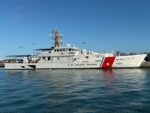Airbus has unveiled the MQ72C Lakota Connector unmanned helicopter concept at the 2025 Association of the United States Army (AUSA) Annual Meeting in Washington D.C., signaling its ambition to enter the tactical VTOL UAV market with a modular platform geared toward both intelligence-gathering and battlefield logistics. The system is designed to integrate into existing U.S. Army aviation infrastructure while offering scalable payload options.
MQ72C Overview: A Rotorcraft-Based Tactical Drone
The MQ72C Lakota Connector is a vertical take-off and landing (VTOL) unmanned aerial system (UAS) based on Airbus’s H145 light utility helicopter airframe—specifically its UH-72A/B Lakota variant used by the U.S. Army. According to Airbus officials at AUSA 2025, the MQ72C is designed as a modular platform capable of performing multiple mission sets including intelligence, surveillance, reconnaissance (ISR), cargo resupply, medevac support, and communications relay.
The airframe retains many of the structural features of the manned UH-72 but replaces cockpit controls with autonomous flight systems and mission-specific payload bays. The design leverages mature rotorcraft technology while incorporating fly-by-wire systems and autonomous flight control software developed in collaboration with Airbus’s UAS division.
Design Philosophy: Modularity Meets Interoperability
The core design philosophy behind the MQ72C centers on modularity and interoperability with existing Army aviation assets. Airbus emphasized that the aircraft can be rapidly reconfigured in-field using mission kits that include EO/IR sensors for ISR roles or cargo pods for resupply missions. The payload bay can reportedly accommodate up to 300 kg of cargo or sensor packages.
- Payload capacity: ~300 kg (modular)
- Range: Estimated >300 km depending on configuration
- Endurance: Up to 4 hours in ISR configuration
- Launch/recovery: VTOL from unprepared sites
- C2 architecture: Compatible with NATO STANAG standards; open architecture avionics
The system is also designed to be compatible with existing ground control stations (GCS) used by manned-unmanned teaming (MUM-T) operations within Army Aviation units. This includes potential integration into platforms such as the AH-64E Apache Guardian or future FLRAA/FTUAS ecosystems.
Tactical Roles: From ISR to Emergency Resupply
The MQ72C is not intended as an armed platform in its current iteration but instead focuses on high-value support roles in contested environments where risk to manned aircraft would be prohibitive. Key mission profiles include:
- Tactical ISR: Equipped with EO/IR gimbals and possible SIGINT payloads for battlefield awareness.
- Cargo Delivery: Autonomous delivery of ammunition, medical supplies or spare parts over short-to-medium distances.
- Medevac Support: Potential future integration of casualty evacuation pods for high-risk extraction zones.
- C3 Relay Node: Acting as an airborne communications relay node in GPS-denied or jammed environments.
This aligns with broader U.S. Army doctrine shifts toward distributed operations where autonomous systems extend reach without increasing risk exposure to personnel.
AUSA Debut Signals Strategic Intent by Airbus
The unveiling at AUSA marks a deliberate push by Airbus into a domain traditionally dominated by North American OEMs such as Boeing Insitu or Textron Systems. While Airbus has extensive experience in manned helicopters globally—including supplying over 480 UH-72s to the U.S.—its footprint in tactical unmanned rotorcraft has been limited until now.
The company’s approach appears focused on leveraging existing military platforms like the H145/UH-72 family while integrating autonomy layers developed through programs such as VSR700—a naval rotary-wing UAV being developed for France’s Marine Nationale.
A senior Airbus representative stated during AUSA that “the MQ72C is not just a concept—it’s an evolution toward fieldable capability within this decade.”
Program Status and Development Roadmap
No formal procurement program exists yet under U.S. DoD funding lines for this aircraft; however, Airbus indicated it is engaging with Army Futures Command and PEO Aviation regarding potential use cases under Future Vertical Lift (FVL)-aligned initiatives such as FTUAS Increment II or Logistics Autonomy Pathfinder efforts.
- Status: Technology demonstrator stage; no flight test data publicly released yet
- Next steps: Ground testing underway; potential flight trials expected late FY2026
- User engagement: Initial outreach ongoing with U.S. Army aviation units and NATO partners
If matured into production form, it could compete against other Group III/IV rotorcraft UAVs such as Northrop Grumman’s Fire Scout series or Leonardo’s AWHero depending on final performance metrics.
Tactical Implications for Future Battlefields
The emergence of platforms like the MQ72C reflects a growing recognition among NATO militaries that rotary-wing UAVs offer unique advantages over fixed-wing drones—especially in urban terrain or mountainous regions where runway independence is critical. The ability to conduct precision landings near frontline units enables more responsive logistics chains compared to traditional aerial delivery methods like parachute drops from fixed-wing aircraft.
If fielded successfully, such systems could reduce reliance on vulnerable ground convoys while enabling persistent overwatch via loitering ISR missions—bridging capability gaps between small quadcopters like RQ-20 Puma and larger HALE assets like MQ-9 Reaper which require runways.
Conclusion: Conceptual Leap Rooted in Proven Platforms
The MQ72C Lakota Connector represents an evolutionary step rather than a disruptive leap—but one grounded in proven airframes adapted through autonomy integration. Its success will hinge not only on technical maturity but also procurement traction within constrained defense budgets increasingly focused on multi-domain operations capabilities.
If Airbus can demonstrate reliable autonomous operation across varied mission sets—and prove cost-effectiveness relative to fielded alternatives—it may carve out a niche role within allied rotary-wing drone fleets over this decade.










